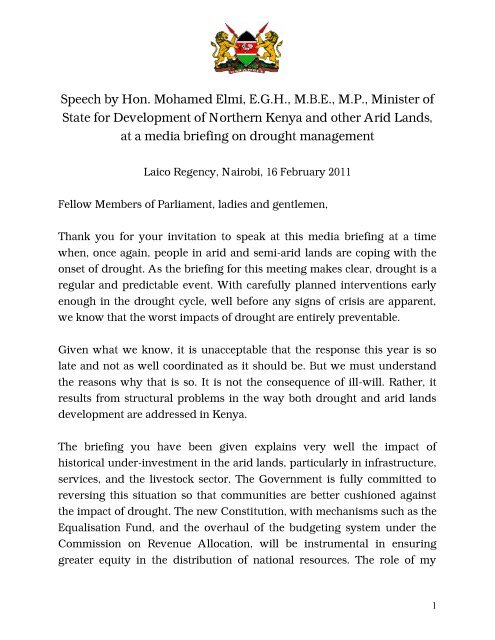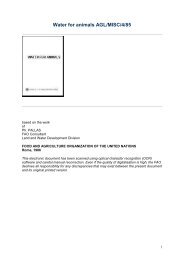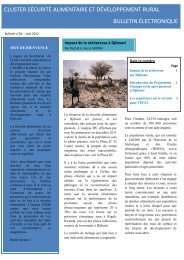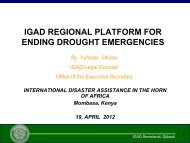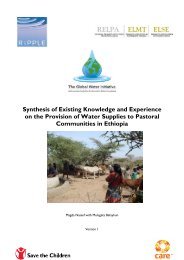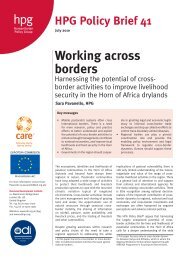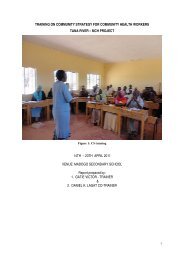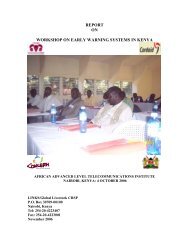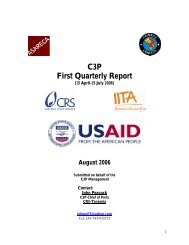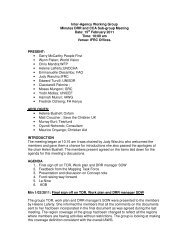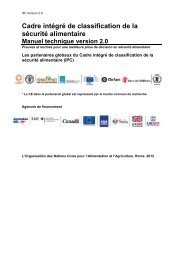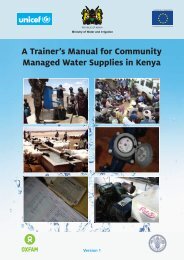Speech by Hon. Mohamed Elmi, EGH, MBE, MP, Minister of State for ...
Speech by Hon. Mohamed Elmi, EGH, MBE, MP, Minister of State for ...
Speech by Hon. Mohamed Elmi, EGH, MBE, MP, Minister of State for ...
Create successful ePaper yourself
Turn your PDF publications into a flip-book with our unique Google optimized e-Paper software.
<strong>Speech</strong> <strong>by</strong> <strong>Hon</strong>. <strong>Mohamed</strong> <strong>Elmi</strong>, E.G.H., M.B.E., M.P., <strong>Minister</strong> <strong>of</strong><br />
<strong>State</strong> <strong>for</strong> Development <strong>of</strong> Northern Kenya and other Arid Lands,<br />
at a media briefing on drought management<br />
Laico Regency, Nairobi, 16 February 2011<br />
Fellow Members <strong>of</strong> Parliament, ladies and gentlemen,<br />
Thank you <strong>for</strong> your invitation to speak at this media briefing at a time<br />
when, once again, people in arid and semi-arid lands are coping with the<br />
onset <strong>of</strong> drought. As the briefing <strong>for</strong> this meeting makes clear, drought is a<br />
regular and predictable event. With carefully planned interventions early<br />
enough in the drought cycle, well be<strong>for</strong>e any signs <strong>of</strong> crisis are apparent,<br />
we know that the worst impacts <strong>of</strong> drought are entirely preventable.<br />
Given what we know, it is unacceptable that the response this year is so<br />
late and not as well coordinated as it should be. But we must understand<br />
the reasons why that is so. It is not the consequence <strong>of</strong> ill-will. Rather, it<br />
results from structural problems in the way both drought and arid lands<br />
development are addressed in Kenya.<br />
The briefing you have been given explains very well the impact <strong>of</strong><br />
historical under-investment in the arid lands, particularly in infrastructure,<br />
services, and the livestock sector. The Government is fully committed to<br />
reversing this situation so that communities are better cushioned against<br />
the impact <strong>of</strong> drought. The new Constitution, with mechanisms such as the<br />
Equalisation Fund, and the overhaul <strong>of</strong> the budgeting system under the<br />
Commission on Revenue Allocation, will be instrumental in ensuring<br />
greater equity in the distribution <strong>of</strong> national resources. The role <strong>of</strong> my<br />
1
Ministry is also to work with other parts <strong>of</strong> Government to ensure that<br />
resources are better aligned with the priorities <strong>of</strong> communities in the arid<br />
lands, and that they accommodate the important realities <strong>of</strong> life in these<br />
areas, such as their sparsely distributed and <strong>of</strong>ten mobile populations.<br />
Turning more specifically to drought management, Kenya actually has a<br />
well-developed and well-respected drought management system. In 23<br />
arid and semi-arid counties there is a community-based early warning<br />
system in operation. Each <strong>of</strong> those counties also produces regular<br />
contingency plans. At national level there are coordination structures that<br />
bring together both government and its development partners. But there<br />
are two problems with this system.<br />
First, it operates within a project framework – the Arid Lands Resource<br />
Management Project within my Ministry. I am sure that when any <strong>of</strong> you<br />
visit the arid lands to gather stories and pictures, it will <strong>of</strong>ten be the Arid<br />
Lands project and associated District Steering Group which facilitates your<br />
movement on the ground. A drought management system that operates<br />
within a partially donor-financed project is not institutionalised, and lacks<br />
the necessary authority to ensure coordination across Government.<br />
That is why my Ministry is proposing the creation <strong>of</strong> a National Drought<br />
Management Authority. This will have four benefits. First, it will direct<br />
specialist and focused attention to drought – even in good years – and thus<br />
permit long-term planning to improve the quality <strong>of</strong> the drought<br />
management system over time, such as factoring in climate change. I have<br />
been personally involved with this system <strong>for</strong> many years, well be<strong>for</strong>e I<br />
joined Government. And I have noticed how easy it is to lose institutional<br />
memory. For example, we used to talk a lot about ‘entitlement’ – the<br />
principle that communities should know what they are entitled to receive<br />
and when they will receive it – but I rarely hear that word used now.<br />
2
Second, an Authority will ensure continuity in drought management,<br />
unaffected <strong>by</strong> <strong>Minister</strong>ial restructuring. Third, it will have the mandate to<br />
ensure effective coordination <strong>of</strong> drought response across Government and<br />
with development partners. And fourth, it will have the credibility and<br />
autonomy to disburse resources based on clearly benchmarked triggers<br />
and guidelines. Drought response should be directed towards the most<br />
needy, not the most noisy.<br />
The second problem with the current drought management system is that<br />
it lacks financial flexibility. Current contingency provisions are relatively<br />
modest in scale and use normal Government disbursement channels,<br />
which are not sufficiently nimble to ensure appropriate action early enough<br />
in the drought cycle. We know that early and more thoughtful response<br />
substantially reduces the negative impact and subsequent costs <strong>of</strong> drought.<br />
There<strong>for</strong>e, my Ministry is also proposing the creation <strong>of</strong> a National<br />
Drought Contingency Fund, which will complement the Authority. The<br />
Fund will be a set-aside contingency fund, which will allow financial flows<br />
to drought-affected areas unimpeded <strong>by</strong> the year-end procedures <strong>of</strong> either<br />
the Government or its development partners. In good years, the Fund will<br />
accumulate. When the first signs <strong>of</strong> drought become apparent, the Fund<br />
can quickly begin disbursing resources against contingency plans. It will<br />
do so in a pr<strong>of</strong>essional and impartial manner, and in a way that inspires<br />
and builds confidence among both public and private donors.<br />
My Ministry is <strong>for</strong>tunate to benefit from the goodwill and support <strong>of</strong><br />
development partners such as the European Community and the World<br />
Bank, both <strong>of</strong> which have supported the design <strong>of</strong> the Authority and the<br />
Fund. All the groundwork <strong>for</strong> these two institutions has been laid. I am<br />
there<strong>for</strong>e confident that both can be established within a short space <strong>of</strong><br />
time. Once they are fully functioning, and in all but the most exceptional<br />
cases, drought emergencies should become a thing <strong>of</strong> the past.<br />
3
Ladies and gentlemen, these two institutions will be important but not<br />
sufficient to ensure that droughts are better managed in future. There are<br />
two other important pillars. The first concerns the NGO community. I<br />
congratulate the REGLAP consortium, and other members <strong>of</strong> civil society,<br />
<strong>for</strong> their persistent advocacy on the issue <strong>of</strong> drought. Innovation is the<br />
niche which NGOs have always occupied. All the features <strong>of</strong> our drought<br />
management system were piloted or initially financed <strong>by</strong> NGOs: the early<br />
warning system, livestock <strong>of</strong>ftake, the growing role <strong>of</strong> cash rather than<br />
food, and the rise in localism – <strong>for</strong> example, contracts with local traders to<br />
supply part <strong>of</strong> communities’ entitlements. I urge you to continue this spirit<br />
<strong>of</strong> innovation, and to keep Government briefed about approaches which<br />
would benefit from wider scale-up.<br />
The second key pillar is the media. In my view, the media’s coverage <strong>of</strong><br />
drought has improved significantly in recent years, both in quantity and<br />
quality. I see stories which are more in<strong>for</strong>med about the underlying<br />
problems facing the arid lands. I see more initiative, and more evidence <strong>of</strong><br />
follow-through. Journalists regularly come to Parliament to put <strong>Minister</strong>s<br />
on the spot. However uncom<strong>for</strong>table that can sometimes feel, I fully<br />
welcome it. The media’s role as public watchdog is fundamental to a<br />
democratic and accountable society. I encourage more <strong>of</strong> the same,<br />
matched <strong>by</strong> a complementary commitment to the responsibilities <strong>of</strong> good<br />
journalism.<br />
In conclusion, ladies and gentlemen, I would like to thank the organisers <strong>of</strong><br />
this <strong>for</strong>um. I believe that it has given all <strong>of</strong> us food <strong>for</strong> thought. I welcome<br />
further dialogue on ways in which the Government can ensure better<br />
drought management – a task which will become more complex as climate<br />
change deepens. And I congratulate both the NGO and media communities<br />
<strong>for</strong> their continued ef<strong>for</strong>ts to hold Government to account in this critical<br />
area. Thank you.<br />
4


